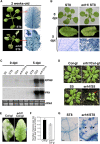An inositolphosphorylceramide synthase is involved in regulation of plant programmed cell death associated with defense in Arabidopsis
- PMID: 19001565
- PMCID: PMC2613663
- DOI: 10.1105/tpc.108.060053
An inositolphosphorylceramide synthase is involved in regulation of plant programmed cell death associated with defense in Arabidopsis
Abstract
The Arabidopsis thaliana resistance gene RPW8 triggers the hypersensitive response (HR) to restrict powdery mildew infection via the salicylic acid-dependent signaling pathway. To further understand how RPW8 signaling is regulated, we have conducted a genetic screen to identify mutations enhancing RPW8-mediated HR-like cell death (designated erh). Here, we report the isolation and characterization of the Arabidopsis erh1 mutant, in which the At2g37940 locus is knocked out by a T-DNA insertion. Loss of function of ERH1 results in salicylic acid accumulation, enhanced transcription of RPW8 and RPW8-dependent spontaneous HR-like cell death in leaf tissues, and reduction in plant stature. Sequence analysis suggests that ERH1 may encode the long-sought Arabidopsis functional homolog of yeast and protozoan inositolphosphorylceramide synthase (IPCS), which converts ceramide to inositolphosphorylceramide. Indeed, ERH1 is able to rescue the yeast aur1 mutant, which lacks the IPCS, and the erh1 mutant plants display reduced ( approximately 53% of wild type) levels of leaf IPCS activity, indicating that ERH1 encodes a plant IPCS. Consistent with its biochemical function, the erh1 mutation causes ceramide accumulation in plants expressing RPW8. These data reinforce the concept that sphingolipid metabolism (specifically, ceramide accumulation) plays an important role in modulating plant programmed cell death associated with defense.
Figures






References
-
- An, Y.Q., McDowell, J.M., Huang, S., McKinney, E.C., Chambliss, S., and Meagher, R.B. (1996). Strong, constitutive expression of the Arabidopsis ACT2/ACT8 actin subclass in vegetative tissues. Plant J. 10 107–121. - PubMed
-
- Balague, C., Lin, B., Alcon, C., Flottes, G., Malmstrom, S., Kohler, C., Neuhaus, G., Pelletier, G., Gaymard, F., and Roby, D. (2003). HLM1, an essential signaling component in the hypersensitive response, is a member of the cyclic nucleotide-gated channel ion channel family. Plant Cell 15 365–379. - PMC - PubMed
-
- Brodersen, P., Petersen, M., Pike, H.M., Olszak, B., Skov, S., Odum, N., Jorgensen, L.B., Brown, R.E., and Mundy, J. (2002). Knockout of Arabidopsis ACCELERATED-CELL-DEATH11 encoding a sphingosine transfer protein causes activation of programmed cell death and defense. Genes Dev. 16 490–502. - PMC - PubMed
-
- Bromley, P.E., Li, Y.O., Murphy, S.M., Sumner, C.M., and Lynch, D.V. (2003). Complex sphingolipid synthesis in plants: characterization of inositolphosphorylceramide synthase activity in bean microsomes. Arch. Biochem. Biophys. 417 219–226. - PubMed
Publication types
MeSH terms
Substances
Associated data
- Actions
- Actions
- Actions
- Actions
- Actions
- Actions
- Actions
- Actions
Grants and funding
LinkOut - more resources
Full Text Sources
Molecular Biology Databases

